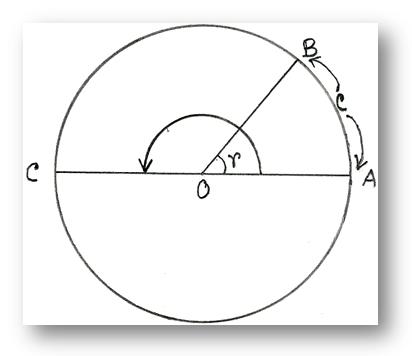Radian is a Constant Angle
Here we will discuss about radian is a constant angle. Let O be the centre of a circle and radius OR = r. If we take an arc AB = OA = r, then by definition, ∠AOB =1 radian.
Let AO be produced to meet the circle at the point C. Then the length of the arc ABC half the circumference and ∠AOC, the angle at the centre subtended by this arc = a straight angle = two right angles.
Now if we take the ratio of the two arcs and that of the two angles, we have
arc AB/arc ABC = r/(1/2 × 2∙π∙r) = 1/ π
∠AOB/∠AOC = 1 radian/2 right angles
But in geometry, we can show that an arc of a circle is proportional to the angle it subtends at the centre of the circle.
Therefore, ∠AOB/∠AOC = arc AB/arc ABC
or, 1 radian/2 right angles = 1/π
Therefore, 1 radian = 2/π right angles
This is constant as both 2 right angles and π are constants.
The approximate value of π is taken as 22/7 for calculation
Corollary:
|
π radian = = |
2 right angles 180° |
If we express one radian in the units of sexagesimal system, we will get
|
1 radian = = = |
180°/(22/7) (180 × 7°)/22 57° 16’ 22” (approx.) |
Basic Trigonometry
Measurement of Trigonometric Angles
Relation between Sexagesimal and Circular
Conversion from Sexagesimal to Circular System
Conversion from Circular to Sexagesimal System
From Radian is a Constant Angle to HOME PAGE
Didn't find what you were looking for? Or want to know more information about Math Only Math. Use this Google Search to find what you need.
Recent Articles
-
Counting Numbers from 1 to 50 | Match the Number | Missing Numbers
Apr 04, 25 03:46 PM
In counting numbers from 1 to 50, recognize the numbers, count and then join the numbers in the correct number order. Here we mainly need eye-hand coordination to draw the picture and maintain the num -
Counting Eleven to Twenty with Numbers and Words |Numbers from 11 - 20
Apr 04, 25 03:21 PM
Counting eleven to twenty with numbers and words are explained below. One ten and one more is eleven. Eleven comes after ten. One ten and two more is twelve. Twelve comes after eleven. -
5th Grade BODMAS Rule Worksheet | PEMDAS | Order of operations|Answers
Apr 03, 25 03:11 PM
In 5th Grade BODMAS Rule Worksheet you will get different types of problems on mathematical expressions involving different operations, mathematical expression with 'brackets' and 'of' and simplifying… -
Worksheet on Simplification | Simplify Expressions | BODMAS Questions
Apr 03, 25 02:58 PM
In worksheet on simplification, the questions are based in order to simplify expressions involving more than one bracket by using the steps of removal of brackets. This exercise sheet -
Divisible by 2 Video |Test of Divisibility by 2 Trick| Rules| Examples
Apr 03, 25 10:25 AM
A number is divisible by 2 if the digit at unit place is either 0 or multiple of 2. So a number is divisible by 2 if digit at its units place is 0, 2, 4, 6 or 8.






New! Comments
Have your say about what you just read! Leave me a comment in the box below. Ask a Question or Answer a Question.